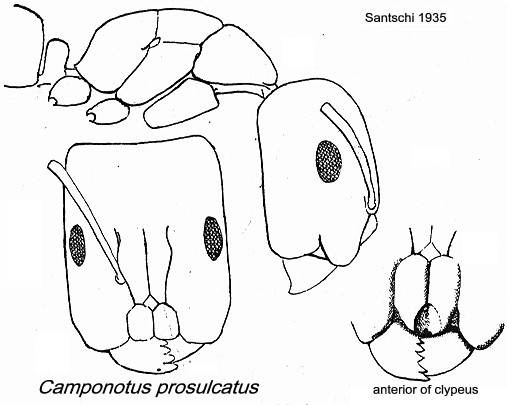Camponotus (Paramyrmamblys) prosulcatus Santschi
  Type locality Zaïre
(Camponotus (Paramyrmamblys)
prosulcatus n. sp., Santschi, 1935a: 284, illustrated, major
worker)
collected at Tua, by Dr J.
Maes, 6.vi.1913, holotype major worker Type locality Zaïre
(Camponotus (Paramyrmamblys)
prosulcatus n. sp., Santschi, 1935a: 284, illustrated, major
worker)
collected at Tua, by Dr J.
Maes, 6.vi.1913, holotype major worker  . .
|
 Santschi's
(1935a) description is at Santschi's
(1935a) description is at  . .
MAJOR WORKER - TL 6.5 mm; HL 2.3, HW 1.6; posterior tibia 1.5 mm. Head
rectangular, obliquely truncate anteriorly; almost one-third longer
than wide; sides parallel, dorsal border straight; posterior angles
shortly rounded. Eyes almost flat, oval, a little larger than one-fifth
the face; situated in the posterior third. Mandibles robust and very
arcuate, distinctly punctuate on the sides and with 5-6 teeth. Clypeus
feebly convex in front, more strongly behind. Postclypeal notch
distinct and deeply impressed. Frontal carinae slightly divergent and a
little longer than the greatest distance apart. Genae raised alongside
the clypeus, less so posteriorly, with a transverse impresion at level
of midpoint of clypeus; with several distinct puncturations. Scape
cylindrical, reaching the posterior border of the head. Thorax segments
almost equal length and forming a regular curve to the propodeal angle;
promesonotal suture clearly impressed. Pronotum longer than wide, a
little flattened posteriorly, sides rounded. Propodeum compressed,
dorsum narrow, feebly convex and not edged laterally; declivity as long
as the dorsum, slightly concave from top to bottom; with a transition
angle of 100° to 112°. Petiole scale (apparently damaged on one side)
narrowed to the rounded summit. First gastral tergite around twice as
wide posteriorly as it is long. Femora flattened, tibiae grooved.
Colour blackish, gaster darker; head and pronotum brown-black;
mandibles, propodeum, anterior of cheeks and frontal area of face
(between carinae), femora and tarsi dull red; pronotum border and
funiculi reddish brown; articulations of trochanters yellowish. Overall
dull; anterior of head more densely reticulate, puncturate and matt.
Gaster finely shagreened and more shiny. Erect pilosity yellowish and
very sparse. Cheeks glabrous. Sparse pubescence on appendages.
This Camponotus has a truncation of the head which, although
somewhat vague, is as strong as some Asiatic members of the subgenus Colobopsis
but the affiliation cannot be judged without seeing the minors.
|
 The photomontage is
of a queen collected in Cameroun,
SW Province; Mt Kupe; Nyasoso Village; at light; 2.iv.2003, collector D
Pryce; OUMNH-2007-042. The photomontage is
of a queen collected in Cameroun,
SW Province; Mt Kupe; Nyasoso Village; at light; 2.iv.2003, collector D
Pryce; OUMNH-2007-042.
This appears to be a close match to the Santschi
description of a major worker, allowing for the sexual
characters. Arnold (1924) noted the queen of Camponotus (Paramyrmamblys) ostiarius
was generally similar to the major worker but, as with this, slightly
larger with a longer head.
|